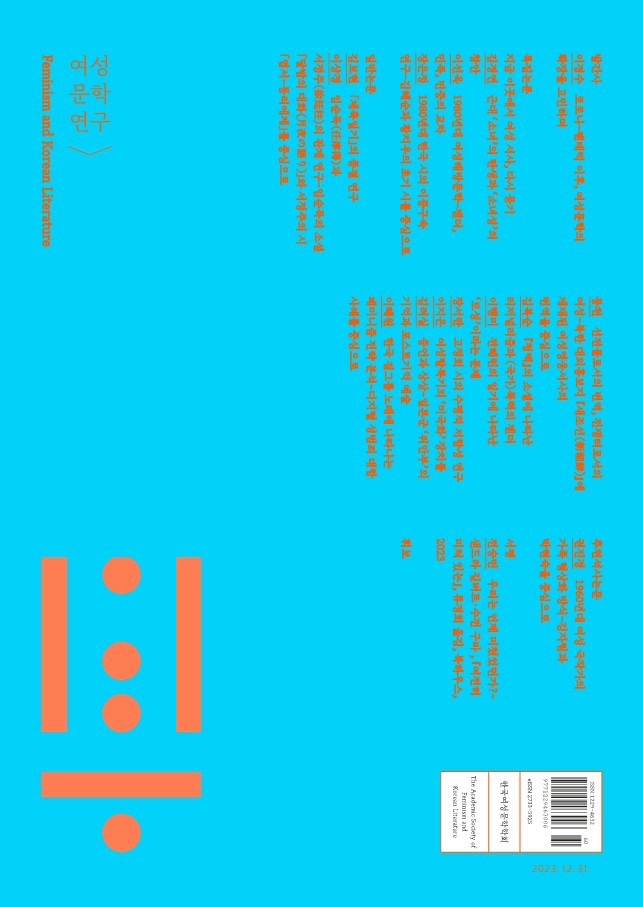- ENGLISH
- P-ISSN1229-4632
- E-ISSN2733-5925
- KCI
 ISSN : 1229-4632
ISSN : 1229-4632
1990년대 여성문학의 지형도 그리기 – 환멸과 각성의 교차로에서 길어 올린 여성주체, 여성적 글쓰기
A Mapping of Korean Women’s Literature in the 1990s : Feminine Subject, and Feminine Writing at the Crossroad of Disillusionment and Awakening
초록
문화적 시간은 선조적으로 흐르지 않는다. 문화의 역사는 지층처럼 겹겹이 쌓여있다. 과거의 지층에서 아직 실현되지 않은 역사적 가능성을 소환하여 미래의 운명과 연결하는 것이 비평의 작업 중 하나라면, 2015년 이후 한국사회에 재부상한 페미니즘과 그 이행과정을 통과하고 있는 지금 우리는 1990년대 여성문학으로 돌아갈 필요가 있다. 1990년대는 여성문학사의 전환점이 되는 연대이기 때문이다. 1989년 베를린 장벽의 붕괴와 1991년 소비에트 체제의 몰락과 함께1980년대 변혁운동이 퇴조하면서 거대 이념에 대한 환멸과 냉소가 1990년대의 지배적 감정구조를 이루고 있었다. 그러나 여성들에게 이 시기는 성적 각성이일어난 시기이기도 하다. 대서사의 붕괴는 거대하게 부풀어 오른 남성주체의 김이 빠지는 광경을 목격하도록 만들었지만, 그 그늘 아래에 억눌려 있던 소주체들의 각성과 반란, 자기발견으로 이어지기도 했다. 환멸과 각성이 교차하는 역사적변곡점에서 1990년대 여성문학은 한국문학의 주변부에 게토화되어 있지 않고중심부로 진입한다. 본 논문은 1990년대 여성문학의 세 시간성 혹은 전선을 ① 1980년대 민족민중문학에 대한 여성주의적 애도를 통한 주변화된 여성존재의복원 (잔존 형태) ② 성적 주체로서 ‘나’의 발견 (지배 형태) ③ 탈젠더화된 포스트개인의 등장과 마이너리티 퀴어 감성의 표출(부상 형태)이라고 보면서, 이 세전선의 중층결합을 통해 1990년대 여성문학의 지향도를 그리고 있다.
- keywords
- 1990년대 여성문학, 여성주체, 여성적 글쓰기, 관계적 주체, 여성윤리, 정체성 정치, 인정의 정치, 다중적 정체성, 진정성, 개인, 퀴어, 포스트젠더, Korean Women’s Literature in the 1990s, feminine subject, feminine writing, relational subject, feminine ethics, politics of identity, politics of recognition, plural identities, authenticity, individual, queer, postgender
Abstract
Cultural time does not flow lineally. Cultural history is layered like strata. If one of the tasks of criticism is to summon unrealized historical possibilities from the strata of the past and connect them with the fate of the future, we need to go back to women’s literature of the 1990s. Women’s literature in the 1990s was a turning point in the history of Korean women’s literature. With the fall of the Berlin Wall in 1989 and the collapse of the Soviet system in 1991, the progressive movement of the 1980s was in decline, and disillusionment and cynicism toward grand narrative became the dominant structure of feeling at that time. However, for women this period was also a time of sexual awakening. The collapse of the grand narrative allowed women to witness the spectacle of the hugely inflated male subject losing its steam, and led them to the awakening, rebellion, and self-discovery. At a historical turning point where disillusionment and awakening intersected, women’s literature in the 1990s was not ghettoized in the periphery of Korean literature, but enters its center. This paper views the three temporalities or fronts of women’s literature in the 1990s as ① the restoration of marginalized women through feminist mourning for the national and popular literature of the 1980s (residual front), ② the discovery of ‘I’ as a gendered subject and experiment of feminine writing (dominant front), ③ the emergence of de-gendered post-individuals and expression of minority queer sensibilities (emergent front), and provides a overall mapping of women’s literature in the 1990s through the overdetermination of these three fronts.
- keywords
- 1990년대 여성문학, 여성주체, 여성적 글쓰기, 관계적 주체, 여성윤리, 정체성 정치, 인정의 정치, 다중적 정체성, 진정성, 개인, 퀴어, 포스트젠더, Korean Women’s Literature in the 1990s, feminine subject, feminine writing, relational subject, feminine ethics, politics of identity, politics of recognition, plural identities, authenticity, individual, queer, postgender
- 40다운로드 수
- 76조회수
- 0KCI 피인용수
- 0WOS 피인용수
